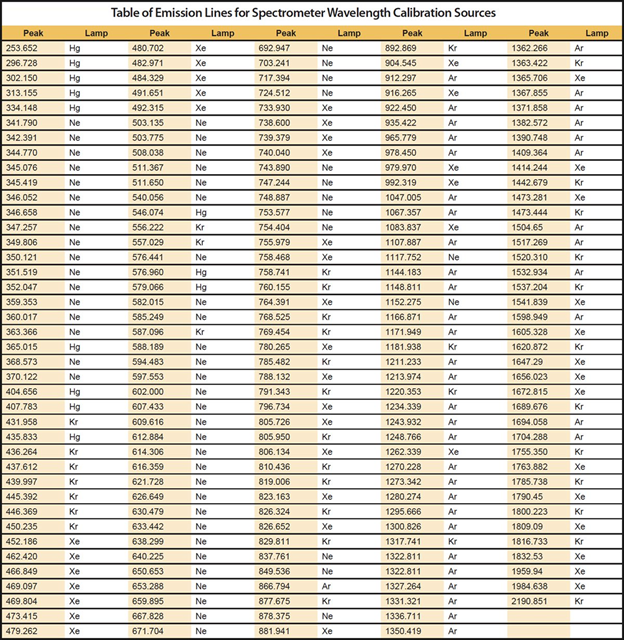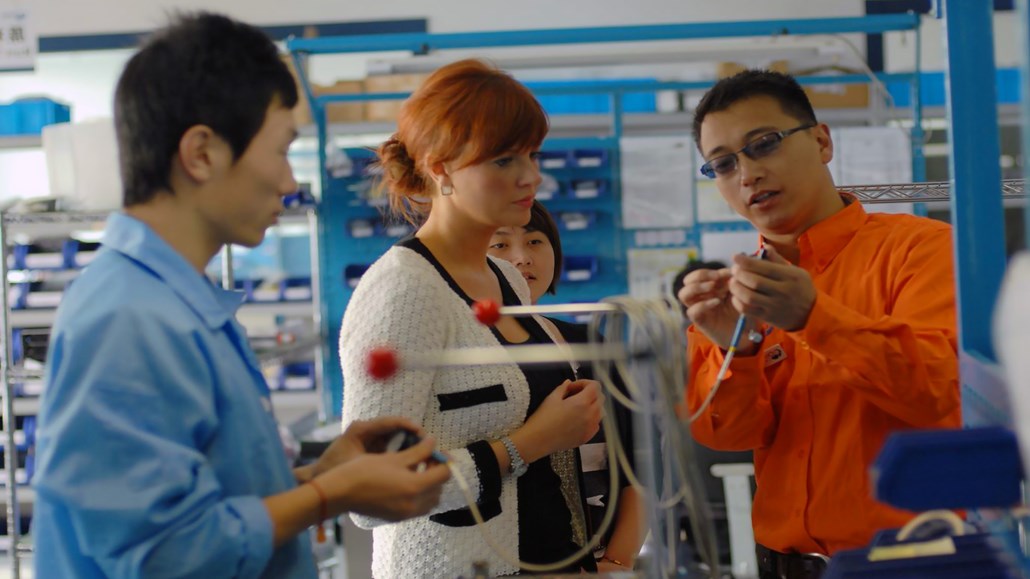Making optical sensing “gettable” by providing simple, clear answers
Our world-class experts are available to help find answers to your toughest questions.

Q: What is covered in the calibration sheet that came with my spectrometer?
A: Every spectrometer we ship comes with a sheet listing its wavelength calibration coefficients (four floating-point values that can be used to derive the wavelength associated with each pixel on the detector), as well as a summary of the spectral lines (from mercury, argon, xenon, neon and other calibrated line sources) used to generate those coefficients.
This calibration sheet contains only a brief overview of the data collected during our automated calibration and alignment process. For example, the pixel values reported on the sheet are “major peak locations” (nearest full-pixel). These pixel values are not sufficient to regenerate and validate the “Predicted λ” column of the calibration sheet.
Our calibration software looks at the surrounding peak characteristics to predict and interpolate a more precise “sub-pixel peak” location. It is this sub-pixel (fractional pixel) that is fed into the linear regression that generates our wavelength coefficients. Without having these fractional peak locations, you will not be able to manually re-generate the “Predicted λ” values to expected levels of precision. (You will arrive at a very close value, well within our accuracy specification, but it may not match the printed value to three decimal places.)
Q: How to perform wavelength calibrations on a modular spectrometer?
A: We offer a Quick Start Guide. Download here.
Q: How accurate are the Ocean Insight radiometric calibration light sources?
A: Ocean Insight uses calibration light sources that can be traced to a standard light source characterized at the National Institute of Standards (NIST). This does not mean necessarily that a specific model light source used for calibration was measured at NIST. Light sources change their output over time as the bulb degrades, and therefore remain within acceptable calibration limits only for the lifetime of the blurb (up to 3,500 hours).
Common practice is to keep a NIST traceable light source as a gold standard, and use it to calibrate other light sources. Each degree of separation from the NIST-calibrated light source introduces some uncertainty, yielding a total estimated uncertainty of within 10% for most Ocean Insight calibration light sources (a value that is typical for the industry). Repeatability of measurements made with a calibrated system will be much higher, typically within 2%.
Q: What emission lines are present within Ocean Insight spectrometer wavelength calibration sources?
A: We offer gas-discharge emission sources for spectrometer wavelength calibration that cover wavelengths ranging from ~250-2500 nm. Refer to the table below to determine the sources best suited for your required wavelength range. By using more emission lines, you can correct more effectively for drift and other phenomena inherent to all spectrometers.

Q: Can a cosine corrector be used in a radiometrically calibrated system?
A: Yes. We can calibrate for absolute irradiance measurements a spectrometer setup with direct-attach cosine corrector. However, disconnecting the cosine corrector after it’s been radiometrically calibrated will invalidate the calibration. Even if the cosine corrector is carefully reconnected, the exact light coupling won’t be replicated. Any changes to the optics or connections require a full system recalibration.
Q: Can a radiometrically calibrated light source be used as a reference for relative irradiance?
A: No! A calibration light source cannot be used as a reference for relative irradiance. The presence of a diffuser in the output path changes the spectrum so that it is not a blackbody source.
Q: Can I change the sampling optics in my radiometrically calibrated system and maintain calibration?
A: No! An absolute irradiance calibration requires that the spectrometer and attached optics be calibrated as a system, since that is the only way to characterize precisely the combined effect of all optical components and optical interfaces.
Any change to the spectrometer configuration, fiber, or sensing optics will change the amount of light hitting each pixel, which invalidates the calibration. Even disconnecting the fiber from the spectrometer and reattaching it can change the response of the spectrometer and affect the calibration. In fact, to prevent this, we seal the fiber connections of systems calibrated on-site at Ocean Insight prior to calibration to help prevent accidental disconnection.
Q: How accurate is the NIST-traceable STAN-SSH-NIST reflectance standard?
A: The high-reflectivity STAN-SSH-NIST reflectance standard is calibrated to a NIST standard with ~1% accuracy from 250-2400 nm.

Our world-class experts are available to help find answers to your toughest questions.